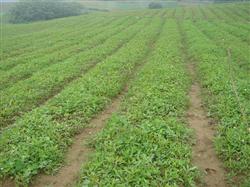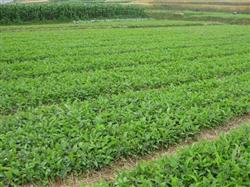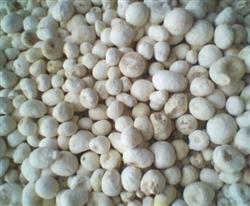How can Pinellia ternata be planted with high yield?

How can Pinellia ternata be planted with high yield? Please give guidance to plant Pinellia ternata in order to achieve high yield, we should grasp the following key measures: intercropping Pinellia ternata likes warm and humid climate, can tolerate cold and shade, but is not resistant to drought and strong light, so Pinellia ternata can be planted in the gentle slope of Banyang, or intercropped with wheat or broad-leaved fruit trees, or intercropped with tall plants such as corn, rape, sorghum, beans, etc. In this way, Pinellia ternata is managed with the same elbow in the management of crops or economic forest and fruit, which not only makes rational use of the land, but also increases the benefit. Carefully cultivating fine seeds of improved varieties is an important guarantee for high yield in planting Pinellia ternata. First of all, excellent individual plants with pure varieties, no diseases and insect pests and strong growth and development should be selected as seed collection mother plants. Secondly, the mother plant of seed collection should be bred alone and the management of water and fertilizer should be strengthened. Thirdly, in order to prevent the varieties from being mixed, it is necessary to collect and store them separately. Finally, tubers with mature, full, large and heavy grains should be harvested in time for planting. According to the experiment, under the condition of 20 ℃ to 25 ℃, when most of the coleoptiles were white, the seedlings were planted and covered with plastic film, which was 30 days earlier than those without plastic film mulching and 25 days earlier than those without plastic film mulching. At the same time, the yield of budding mulch was 52.6% higher than that of the control, and the yield of non-budding mulch was 29.8% higher than that of the control. After the bud was accelerated and planted, the Pinellia ternata species completed the internal physiological changes before germination in advance, and the ground temperature increased and reached the temperature needed for seedling emergence ahead of time, and the buds grew out of the ground quickly. In addition to preserving soil moisture and increasing temperature and emergence ahead of time, bud mulching can also make the soil loose, benefit the growth and development of roots, make the plant resistant to drought and waterlogging, always maintain exuberant absorption function and physiological function, and lay the foundation for high yield of Pinellia ternata. When covering the film, the plastic film should be flat and close to the ridge of the border, compacted with soil, so that it is tight, flat and strict. When the temperature is stable at 15 ℃ to 18 ℃ and about 50% of the seedlings emerge, remove the plastic film to prevent the seedlings from being injured by high temperature in the film, and refine the seedlings before removing the film. The method is to open the ventilation and heat dissipation from both ends of the bed at noon, seal it in the evening, and then remove it all after a few days in a row. It is an important measure to increase the yield of Pinellia ternata by delaying the mulch in the high temperature period, gradually entering the high temperature season, keeping the border surface moist and delaying the withering time of the aboveground part of Pinellia ternata as far as possible. According to the experiment, rice straw and wheat straw (chaff) were covered from mid-May to mid-June every year, and the seedling was only 5% in late July, growing well, while that in the control group was as high as 78%. From this point of view, ground mulching can correspondingly prolong the growth period of Pinellia ternata, the period of photocooperation is also relatively prolonged, photosynthate accumulates more in tubers, and the larger the tuber is, the higher the yield is, which is 123.78% higher than that of the control. In addition, the number of weeds in the covered area was significantly lower than that in the uncovered area, and the incidence of leaf rot decreased significantly, which was also an important reason for the yield increase of Pinellia ternata. If Rain Water is large and the soil moisture is too much, the covered wheat straw should be removed in time to prevent underground tubers from rotting and reducing production. The plant of Pinellia ternata is short and small, so it is necessary to loosen the soil and weed frequently during the growth period to avoid grass famine. The depth of intertillage should not exceed 5 cm to avoid root injury. Because the root of Pinellia ternata grows around the tuber, and its root system is concentrated in the topsoil layer of 12 cm to 15 cm, the middle ploughing should be shallow rather than deep, except early, small and small. Pinellia ternata was planted in early spring and covered with plastic film. at the same time, weeds such as Equisetum equisetifolia, Euphorbia angustifolia, amaranth, small spiral flowers, gray vegetables, purslane and other weeds were also unearthed, and the quantity was large, affecting the yield of Pinellia ternata. Therefore, Acetochlor can be used to control pre-bud weeds of Pinellia ternata, and then covered with plastic film after spraying herbicide on the ground in early spring, which has a good control effect on many kinds of weeds (the specific usage is in accordance with the drug instructions). In addition, in artificial cultivation of Pinellia ternata, different herbicides can be selected according to different seasons, the herbicide of spring sowing Pinellia ternata should be selected, and the herbicide of spring sowing and Acetochlor can be selected. The practice of spraying chemical fertilizer to promote high yield shows that spraying sodium sulfite solution in high temperature and drought period can increase the yield of Pinellia ternata. Because when the temperature of Pinellia ternata lasts as high as 30 ℃ in summer, the respiration of Pinellia ternata is too strong due to high temperature and strong light, which consumes more substances than that accumulated by photosynthesis, resulting in the destruction of cell protoplast structure and "seedling collapse". As far as the production of Pinellia ternata is concerned, the "inverted seedling" shortens the growth period of Pinellia ternata and seriously affects the yield of Pinellia ternata. Therefore, taking measures to delay or reduce the "falling seedlings" of Pinellia ternata in summer is an important condition to realize the high yield and high quality of Pinellia ternata. In addition to adopting appropriate shading and sprinkler irrigation to reduce light intensity, air temperature and ground temperature, plant respiratory inhibitor sodium sulfite 0.01% solution can also be sprayed, and a mixture of 0.01% sodium sulfite, 0.2% urea and 2% superphosphate can also be sprayed to inhibit respiration of Pinellia ternata and reduce the consumption of photosynthates, thus delaying and reducing "inverted seedlings", which can achieve obvious yield-increasing effect. Click to get more planting techniques of Pinellia ternata
- Prev

How to plant Pinellia ternata for three crops a year?
How to plant Pinellia ternata for three crops a year? To introduce the planting of Pinellia ternata, if you want to grow three crops a year, you can refer to the following planting methods: first, select land for land preparation and plant Pinellia ternata with loose and fertile soil. When preparing the soil, we apply 3000 Mu of miscellaneous fertilizer, 30 kg of phosphate fertilizer, 100 kg of plant ash, and no ammonium bicarbonate.
- Next

How to plant Pinellia ternata for high yield
How can Pinellia ternata be planted with high yield? Please give an introduction to planting Pinellia ternata in order to achieve high yield, it is necessary to understand its growth habits. References are as follows: 1 morphological characteristics of perennial herbs, underground tuber bulbs are oblate, with a diameter of 1mi 2 cm, and most fibrous roots in the lower part. The 1-year-old leaves are simple, and the 2-3-year-old leaves are deeply divided.
Related
- Fuxing push coffee new agricultural production and marketing class: lack of small-scale processing plants
- Jujube rice field leisure farm deep ploughing Yilan for five years to create a space for organic food and play
- Nongyu Farm-A trial of organic papaya for brave women with advanced technology
- Four points for attention in the prevention and control of diseases and insect pests of edible fungi
- How to add nutrient solution to Edible Fungi
- Is there any good way to control edible fungus mites?
- Open Inoculation Technology of Edible Fungi
- Is there any clever way to use fertilizer for edible fungus in winter?
- What agents are used to kill the pathogens of edible fungi in the mushroom shed?
- Rapid drying of Edible Fungi

